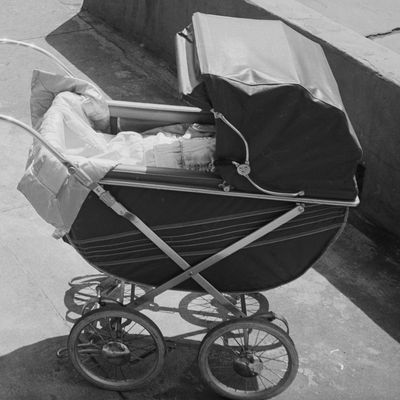
The cost of childbirth in the United States is significantly higher than in any other country in the world. Depending on where you live, average medical bills, with insurance, can range from about $4,500 to $11,200 for a vaginal delivery; for C-sections, it’s $5,100 to $15,000. (Without insurance, costs can be much higher.) To make matters more infuriating, many parents won’t know how much their delivery will cost until they get the bill afterward.
There aren’t many good options for reducing childbirth costs, especially for higher-risk pregnancies. As a result, many parents are forced to get creative with how they approach their health-care bills. Here, five women discuss the ways they dealt with them.
“We asked for an interest-free payment plan, and the hospital said yes.”
—Katy, San Francisco
With each of my two children, I had C-sections. I left the hospital both times with a bill for over $12K.
We didn’t have our second kid until we’d finished paying off the hospital bill for our first, which took about two years on an interest-free payment plan. After I had my second child last fall, I called the hospital and explained our situation. We were really strapped because my partner and I are both freelancers, so our income took a big hit during COVID. After some negotiating, the hospital put us on a payment plan with no interest and pretty low monthly bills — less than $200 per month, which was much lower than our first plan. At the rate we’re going, I think we’ll pay it off within five years. Obviously, I wish we didn’t have this debt, and that our health-care system wasn’t so messed up, but it’s not going to ruin us. A friend of mine put all her childbirth bills on her credit card, and that’s not a good idea. I think a lot of people don’t realize that you can pay off medical bills gradually like this, and that hospitals can be somewhat understanding when you talk to them.
“I went on Medicaid.”
—Jessica, Washington, D.C.
I was about five months pregnant when the pandemic happened and I lost my job. My husband and I both work in hospitality, and we were panicking. Paying for COBRA was so expensive, but buying my own health insurance plan seemed prohibitive, too. I just didn’t see how we were going to be able to afford my medical bills.
A friend of mine suggested that I apply for Medicaid. I was worried that I wouldn’t qualify, since before I lost my job I made pretty decent money. But I didn’t realize that pregnant women get special eligibility in a lot of states, including mine. I applied and was accepted. I didn’t even have to switch doctors, which was great.
I didn’t realize how common it was for pregnant women to use Medicaid [Medicaid paid for 43 percent of all births in 2018], although it shouldn’t have surprised me — I don’t know how most people would afford these bills otherwise. My premiums were under $100 a month, and when I gave birth to my daughter, my hospital bill was less than $2,000. We’ve had some very lean months, and none of it has been easy, but with unemployment we’ve been okay.
It was a weird dance to figure out when my husband should find a new job, since it meant we probably wouldn’t qualify for Medicaid anymore. He started looking over the summer, but he couldn’t find anything that would offer health insurance, so he decided to wait until after the baby was born. He finally started working again in October, and then got laid off again in January, and then hired again in March. I haven’t been back to work since we had the baby; it made more sense for me to stay home and take care of her. But I’m starting to look for new jobs now. If I can find one that pays enough for us to afford day care, I’ll take it.
“We had to call our insurance company from the hospital to see what was covered.”
—Amy, New York
With my first baby, our hospital bill was an astronomical amount of money, like $11,000, even though I didn’t have a C-section and had good insurance. When I went through it, I noticed a five-figure charge that was just marked “nursery.” I made some calls, and it turned out to be from when the nurse took our baby away for about 20 minutes to do some tests. In the hospital, it was presented as being completely routine, and I had no idea that they would bill us for the “nursery,” which was where the tests were done.
When I had my second baby, my daughter, I was very insistent that she not go to the “nursery,” because I didn’t want to get that charge again. Then one of the doctors specifically wanted to see her in the nursery for a test, and I explained to the nurse why I didn’t want that. She was like, “Just call your insurance company and see if the nursery is covered.”
You’d think that calling an insurance company is going to be a horrible ordeal, but it was fine — we got a person on the phone pretty quickly. We asked if they could cover the cost of our newborn to go to the nursery for a checkup, and they said yes. They also said that the only thing that wasn’t covered was the hearing test, which seemed ridiculous because that’s important for newborns and every hospital does it. But just in case, we declined the hearing test at the hospital and had it done as an outpatient procedure at the pediatrician’s, where it was covered.
Also with our second baby, we were getting ready to leave the hospital when I got a call from the billing department asking us to pay in full right there. I said no — we would pay the copay, but not the full bill until I received it and could review the charges. It was crazy that they were pressuring us to pay it all in that moment, and I’m glad I pushed back. Once we did get the bill, my husband called the insurance company and asked if they could reduce it, and they said yes — apparently they’d made a mistake on it.
The takeaway is to call your insurance company, ideally before you deliver, to see what will be covered. And then call again once you get the bill, because they mess things up all the time.
“We had to move to get better health insurance.”
—Tenique, Chicago
When I got pregnant, my partner and I had been trying for a couple of years. We’d basically gotten to the point where we thought it wasn’t going to happen for us, and made peace with that. Then I got pregnant right before the pandemic started. It caught us by surprise, and while we were happy, we were also unprepared. We had a very bare-bones insurance plan that only cost about $200 a month, but it quickly became clear that it would cost us a lot more on the back end.
My pregnancy was technically high risk, because I was 40, so my doctor wanted me to get an ultrasound and bloodwork every month — which cost about $600 per appointment, after insurance. I did some back-of-a-napkin math and it looked like I was going to spend at least $6K on medical bills before I even delivered. And I know the hospital bill could have been up to $20K or even more, because we had such a high deductible. Pregnancy isn’t a qualifying life event to switch insurance plans, so we were trapped. It gave me a ton of anxiety.
One blessing of the pandemic was that both our companies switched to remote work. So, after a lot of back-and-forth, my partner and I decided to leave Brooklyn and move back to Chicago, where I’m from and where my family still lives. Changing our residency did allow me to change health-insurance plans, and so I picked one with much higher monthly premiums that ultimately saved me a ton of money because it covered a lot more. The move wasn’t cheap or easy, of course. But we more than made up for those expenses in what we didn’t have to spend on my delivery. Our hospital bill was about $5K total — still a lot of money, but way less than we would have had to spend if we were stuck with our old plan.”
“We’re having our baby in Australia, because it’s practically free.”
—Zara, Brooklyn/Sydney
My husband and I are Australian citizens, but we’ve been living and working in New York for several years. I got pregnant about two years ago, right before we went back to Australia for the holidays to see family, and then I miscarried while we were there. It was awful, but the medical care I got in Australia was really good. I was pretty far along when I miscarried, and I had to get a D&C procedure. The doctors and medical staff made me feel really safe and well cared for, and I don’t even remember getting a bill for it.
We don’t have health insurance in the U.S. We own our own business, and we’ve always been healthy, so if we have to go to the doctor we just pay out of pocket. I get it that it’s a risk, but we just decided to take it.
When I got pregnant again at the end of last year, we had a lot of conversations about whether we should buy health insurance, and what the cost would look like. Ultimately, we decided that it would be best for us to go back to Australia for the birth. I paid out of pocket for my 12-week and 20-week appointments in New York, and in both cases it was a couple hundred dollars. Dealing with those bills was really like a second job, though. It’s amazing to me that you ask your doctor how much something will cost if you’re paying out of pocket, and they have no idea. There’s just no transparency. I had to make tons of phone calls to labs and different doctor’s offices to research prices and figure out what to do.
We gave up our apartment in Brooklyn and came to Australia to stay with family when I was about five months along. Our flights were expensive — over $2,000 one way, for each of us — and there’s a rule here that you have to quarantine in a hotel for two full weeks after you arrive, which costs a $3,000 flat fee in Australian dollars, plus $1,000 for each additional person. So we had to pay $4,000 total for that, which is about $3,000 in U.S. dollars. But medical bills here are so much lower than in the U.S. that it was still worth it. Compared to the U.S., it’s practically free. I know that most people don’t have this option, and we’re really lucky that we do.





